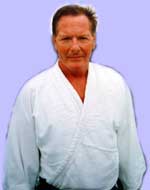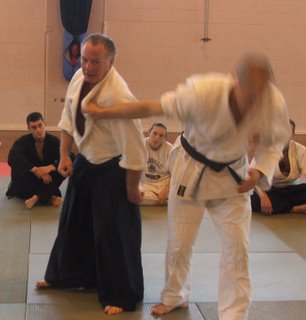Day 2 - Aikido - Sensei Gwynne Jones - 8th Dan
Aikdo has been called one of the most subtle and sophisticated of the martial arts derived from Japaneese Bujutsu (the warior arts).
Aikido is a Japanese martial art developed by Morihei Ueshiba (often referred to by his title 'O Sensei' or 'Great Teacher').
It appears to be a martial art involving some throws and joint locks that are derived from Jujitsu, and some throws and other techniques derived from Kenjutsu (sword based martial art). Aikido does not focus on punching or kicking opponents, but rather on using an attacker's own energy to gain control of them or to throw them away from you.
Movements and posture are extremely important, rather than just blocking and throwing your opponent. Circular movements are not just in one plane but in three dimensions or spherical movements.
The founder was a poet and an artist as well as a martial artist. He studied many traditional arts, including the 'fighting' arts, such as jiujitsu and kenjutsu.
In 1925 he defeated a master of 'kendo' without actually fighting because he saw where the attack was to fall and avoided it. The founder explained that Aikido should not taught openly to everybody in public, as the techniques are difficult to master safely without cooperation and trust and could be misused. The essentials include speed, timming, concentration of power and moving the centre of gravity.
The practice of techniques and other exercises leads to greater confidence and can be used for physical training. Relaxation and strength is developed without the aggression that 'fighting' seems to encourage. Many of the techniques have been adapted for use by the police because they are designed to defend against a range of attacks including grabs and strikes by objects, often leading to the controlling of the attacker and the removal of the weapon. Some practices may be carried out, without an opponent, so as to learn moves or sequences (Kata).
In Aikido in addition to a gi and a belt a Hakama may be worn, in some schools only when you reach a dan grade, The Hakama is the traditional skirt or voluminous pants worn by the japaneese Samurai. In theory this hid the feet so opponents could not use foot position to their advantage. In Aikido the version worn is the horse back riding style of huge pleated pants.
Sensei Gwynne Jones 8th Dan
 Sensei's style is both Aikikai and Ki Aikido blend. Both soft and harmonious, yet solid. Using traditional aikido and Tohei sensei's Ki training. Sensei Jones trained with Tohei Sensei in 1978 and 1979 when he came to UK at Swansea university. He also did numerous seminars with Chiba Sensei, Tamaru Sensei and Yamada Sensei. He started aikido in 1961 with traditional aikido, but now blends the two styles. It is dynamic aikido, not static, but still uses the solid basics at Kyu grade level. He also researches new development as he believes that aikido needs to expand from different forms of attack.
Sensei's style is both Aikikai and Ki Aikido blend. Both soft and harmonious, yet solid. Using traditional aikido and Tohei sensei's Ki training. Sensei Jones trained with Tohei Sensei in 1978 and 1979 when he came to UK at Swansea university. He also did numerous seminars with Chiba Sensei, Tamaru Sensei and Yamada Sensei. He started aikido in 1961 with traditional aikido, but now blends the two styles. It is dynamic aikido, not static, but still uses the solid basics at Kyu grade level. He also researches new development as he believes that aikido needs to expand from different forms of attack.Training
The posture or stance in akidio is shorter than karate, assuming the shape of a three sided pyramid, the back foot 90 degrees to the front foot and approx 15 degrees off the centre line.
Left : Sensei demonstrates knife defences with one of his Uke's. Sensei enters off line before applying a wrist lock and finishing with a take down.
 Right: SMJR J Picket from the Royal Dutch Navy throws Col Dave Hopwood (I believe),
Right: SMJR J Picket from the Royal Dutch Navy throws Col Dave Hopwood (I believe),Col Dave seemed to spend most of the week being hit or thrown by someone.
At the end of the day SMJR Picket presented some beautiful display boards depicting the history and development of Aikido and Ju-Jitsu to Sensei Gwynne Jones and Brig Graham Hopkins for their contributions to the Army Martial Arts Association.
In Aikido there is much emphasis on Ki this can be defined as "attention", or "mind" or "intent" although many feel that that Ki defines some sort of "magic" and since they do not believe in magic they cannot beieve in Ki. Those who emphasize Ki training tend to insist Ki is not magic at all but a blend of Mind and Body. Nearly ten years ago I saw my late TE-AT-SU chief Instructor Shihan Dave Parker do a demonstration with mutiple black belt attackers. He effortlessly redirected the energy of his attackers as they sailed through the air, I could not even see what he was doing to obtain such spectacular results, this first sparked my interest in Aikido and today I was getting my first real taste.
Talking about taste that has reminded me about Senseis cup of tea with ten sugars in it. When Sensei was talking about being relaxed, the feeling of relaxing it is impossible to explain, you have to know by experience. You would know the difference between a cup of tea with no sugar or ten sugars but how would you explain it...you could say it was sweet...but how will that help someone who has not experienced sweet. Throw demonstrations like the unbendable arm you can help people begin to understand the concept of relaxing and ki.
Sensei showed us the ki demonstration of the unbendable arm, this demonstrates the power of the goal. The feeling that that energy is flowing from the fingers, exhibiting a strength that is beyond physical capacity.
Left: Sensei just uses the transfer of his body weight to counter Col Daves attack.
Sensei talked about being off line and keeping you centre of graviy lower than your opponent to assist in your throws and your stability.
In Aikido the movements are very circular and you move around your opponent rather that backwards and forwards togeather like in some other martial arts.
Sensei also talked about "Maai" the appropriate distance for both attack and defense, a distance of approx 2 metres should be maintained.
Links
Video
Aikido (The Art of Peace and Harmony)
This is post three in a series of six on the AMA course.
If you have jumped into the middle of our blog via a search engine you may want to go to our latest post; please follow the link below that will relaunch the blog






0 Comments:
Post a Comment
<< Home